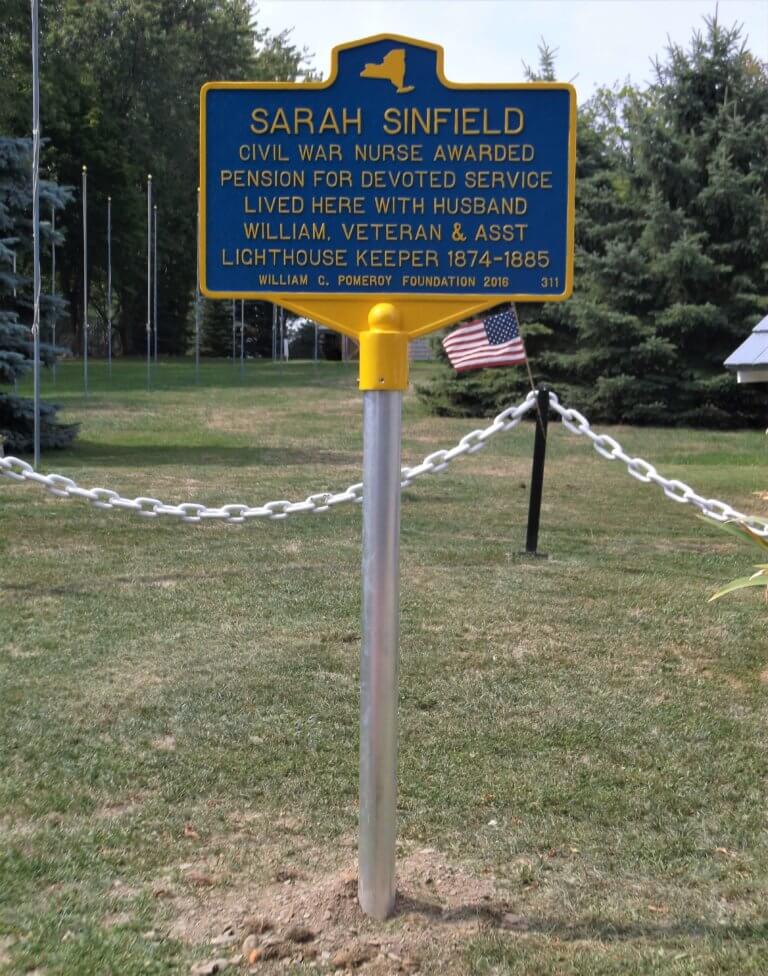SARAH SINFIELD
- Program
- Subject
- Location
- Lat/Long
- Grant Recipient
-
NYS Historic
-
People, Site
- 1 Point Drive North, Dunkirk, NY
- 42.493663, -79.353894
-
Dunkirk Historical Lighthouse and Veterans Park Museum
SARAH SINFIELD
Inscription
SARAH SINFIELDCIVIL WAR NURSE AWARDED
PENSION FOR DEVOTED SERVICE
LIVED HERE WITH HUSBAND
WILLIAM, VETERAN & ASST
LIGHTHOUSE KEEPER 1874-1885
WILLIAM G. POMEROY FOUNDATION 2016
On July 5, 1884, the U.S. Congress passed a special act to award Sarah Sinfield (1823-1894) of Dunkirk, Chautauqua County, New York a pension for her devoted service during the Civil War. At the time, there were no laws allowing women to receive a pension, and it required a special act of Congress for a woman to successfully receive a pension for her war service. Prior to its passage, accompanying the bill that would recognize Mrs. Sinfield’s service, was a report from the Committee on Invalid Pensions. The report detailed both her and her husband William’s efforts and sacrifices made during the Civil War:
“Her husband, William Sinfield, volunteered as a private in Company E, Seventy-second Regiment New York Volunteers, at Dunkirk, N.Y., in April, 1861, and went from there to Staten Island in May following. About the 20th of July, 1861, Captain Barrett, of the company of which her husband was a member, left Dunkirk to join his company, and upon her request and that of her husband, took her with him. The day after her arrival at Staten Island the regiment left for Washington, and she accompanied it.
From Washington she followed the regiment, and was with it at the battles of Williamsburg, Peach Orchard, Fair Oaks, Seven Pines, the seven days’ fight, the second battle of Malvern Hills, the second battle of Bull Run, the second battle of Manassas, the battles of Chantilly, of Fredericksburg, of Chancellorsville, and of Gettysburg.
At each and every one of these battles she aided in caring for the sick and wounded soldiers, carrying food and drink to those who could not help themselves, preparing bandages for wounds, and in many and various ways making herself useful, and putting up with such accommodations as were furnished soldiers. At no time was she absent from the regiment until after her husband was wounded and sent to hospital for treatment, but endured all the fatigue and hardships of a soldier’s life in camp and on the march.”
After Mr. Sinfield received a shell wound to his left knee at Gettysburg, he was sent to the Fort Smith hospital in Rhode Island. Mrs. Sinfield accompanied her husband to the hospital and was employed as an assistant nurse at the hospital until her husband was discharged in May 1864, when they both returned to Dunkirk, New York.
In 1872, Mr. Sinfield was awarded an increase in his pension from 8 dollars to 18 dollars per month, after an examining surgeon found that he was still suffering significantly from his shell wound. The surgeon ruled that his disability was “equivalent to loss of foot for purposes of manual labor.” Despite this increase, the couple continued to struggle financially. Then finally, in July 1884, Mrs. Sinfield was awarded a pension of 15 dollars a month for her devoted service during the war.
From 1874-1885, Mr. Sinfield served as assistant lighthouse keeper in Dunkirk. Given his disability, it is likely that Mrs. Sinfield aided her husband greatly in this role. Mrs. Sinfield passed away in April 1894 and is buried in Forest Hill Cemetery Fredonia, New York. Her husband relocated to Ohio after her death, passing away in April 1899. He is buried in Dayton National Cemetery in Dayton, Ohio.

